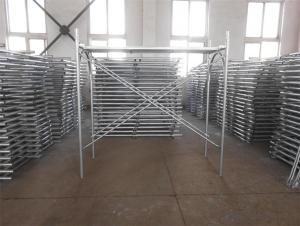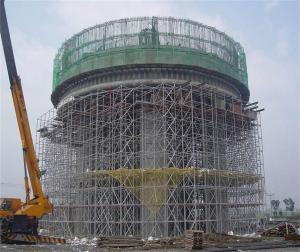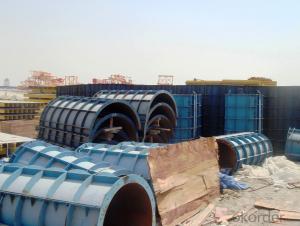Door Scaffolding , Ring lock, Tower Scaffolding with Hot or Cold Galvanized Surface
- Loading Port:
- Shanghai
- Payment Terms:
- TT OR LC
- Min Order Qty:
- 1000 m²
- Supply Capability:
- 100000 m²/month
OKorder Service Pledge
OKorder Financial Service
You Might Also Like
1.Structure of Ring lock Description
Ringlock Scaffolding system is the most popular used Scaffolding system in the world.It will greatly reduce the cost because of the following advantages
Packaging & Delivery
Packaging Details:
Pallet or bag or upon client's request
Delivery Detail:
35days
2.Main Features of Ringlock
It will greatly reduce the cost because of the following advantages
1)Using less pipes
2)Easy to install
3)It can be used again and again for nearly 20years
3.Ring lock product pictures:
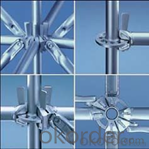
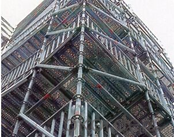
4.Ringlock Product Description
Type: ringlock scaffolding diagonal Brace
specification : Ø48.3×3.20
material:: steel Q235
Finished: Hot DIP galvanized, painted
Diagonal length(m) :Weight(kg)
0.9m * 1.25m 6.28
1.25m * 2.7m 11.45
5.FAQ
We have organized several common questions for our clients,may help you sincerely:
1)How about your company?
CNBM International Corporation, China National Building Materials (Group) Corporation, is one of the largest companies in China building material equipment industry, Our formwork and scaffolding are largely used in both domestic and all over world;
2)How many Scaffolding your company have?
Here comes our 5 types of Scaffolding systems:
- Cup lock Scaffolding(C-Lock Scaffolding)
- Ring lock Scaffolding
-Kwistage Scaffolding
-H-frame Scaffolding
-ID15 Scaffolding Tower, this type Scaffolding is the most widely used in construction, such like bridge.
3)How long can we receive the product after purchase?
Lead time is about 30days after getting the signed PI and deposit.
- Q:How does steel frame formwork ensure accurate dimensions and alignment?
- Steel frame formwork ensures accurate dimensions and alignment through its rigid and sturdy structure. The steel frames are designed and manufactured with precision, ensuring that they are perfectly straight and of the correct dimensions. This allows for the formation of uniformly sized and aligned concrete structures. The steel frames are assembled together to create a robust framework that provides stability and support during the concrete pouring process. The frames are securely fixed in place, preventing any movement or shifting during the casting of the concrete. This eliminates the risk of any dimensional variations or misalignments in the final structure. Additionally, steel formwork allows for precise adjustment and leveling. The frames are equipped with adjustable props, wedges, and clamps, which can be used to fine-tune the position and alignment of the formwork. This enables the construction team to achieve accurate dimensions and alignment as per the project specifications. The steel frame formwork system also ensures dimensional accuracy by providing a smooth and seamless surface finish. The steel panels are constructed with high-quality materials that prevent any warping or bending, resulting in a consistent and even surface. This eliminates the need for excessive plastering or finishing work, further enhancing the accuracy of the dimensions and alignment. Overall, the use of steel frame formwork in construction projects guarantees accurate dimensions and alignment by providing a strong and stable framework, allowing for precise adjustments, and delivering a smooth surface finish. This ensures that the final concrete structures meet the required specifications and achieve the desired level of accuracy.
- Q:Are there any restrictions on the tolerance levels that can be achieved with steel frame formwork?
- Tolerance levels for steel frame formwork are subject to certain restrictions. Although this formwork system provides greater precision and accuracy compared to traditional methods, there are still limitations to consider. The quality of the steel frame formwork itself is a major factor that affects tolerance levels. If the formwork is not manufactured to high standards or has sustained damage, it can compromise the accuracy of the resulting structure. Therefore, it is crucial to ensure that the formwork is of high quality and properly maintained. In addition, the expertise of the workers handling the steel frame formwork can also impact tolerance levels. Improper installation or handling can result in misalignment or deviations from the desired tolerances. Hence, it is important to have skilled and experienced workers who are trained in using this type of formwork. Moreover, specific structural elements and design requirements may impose their own limitations on achievable tolerance levels. For instance, complex geometries or intricate connections can pose challenges in attaining high tolerances compared to simpler designs. Lastly, external factors such as environmental conditions can also affect tolerance levels. Temperature, humidity, and wind can influence the stability and dimensional stability of the formwork, potentially leading to deviations from the desired tolerances. In conclusion, while steel frame formwork offers enhanced precision and accuracy, there are still restrictions on achievable tolerance levels. These limitations stem from the quality of the formwork, the skill of the workers, design requirements, and external factors. However, by ensuring high-quality formwork, employing skilled workers, considering design limitations, and mitigating external factors, relatively high tolerance levels can be achieved with steel frame formwork.
- Q:What are the different types of formwork supports used with steel frame formwork?
- There are several different types of formwork supports that can be used with steel frame formwork. Some common examples include adjustable steel props, scaffold frames, and shoring systems. These supports are used to provide stability and ensure the formwork remains in place during the concrete pouring and curing process.
- Q:Can steel frame formwork be used for both commercial and residential construction?
- Yes, steel frame formwork can be used for both commercial and residential construction. Steel frame formwork is a versatile and durable system that is suitable for a wide range of construction projects. It offers several advantages such as high strength, stability, and reusability, making it ideal for both small-scale residential buildings and large commercial structures. The steel frame formwork system can be easily assembled, disassembled, and adjusted to accommodate different project requirements, making it a cost-effective solution for various construction applications. Whether it is for constructing residential houses or commercial buildings like offices, hospitals, or shopping malls, steel frame formwork provides a reliable and efficient method for creating concrete structures.
- Q:Can steel frame formwork be used in areas with high temperature variations?
- In regions where temperature variations are high, steel frame formwork is an ideal choice. This is due to steel's exceptional durability and strength, which allows it to withstand different weather conditions. Unlike other materials, steel remains stable and intact even with significant changes in temperature. This unique quality makes steel frame formwork particularly well-suited for construction projects in areas with extreme temperature fluctuations. Moreover, steel formwork is resistant to warping, cracking, or deforming, making it even more suitable for high-temperature environments.
- Q:How does steel frame formwork contribute to the overall acoustics of a structure?
- Steel frame formwork does not directly contribute to the overall acoustics of a structure. The primary function of steel frame formwork is to provide temporary support and shape for the concrete during the construction process. It is a framework that holds the concrete in place until it hardens and gains its structural strength. However, the overall acoustics of a structure can be influenced by the materials and design choices made during the construction process. Factors such as the selection of building materials, insulation, and the design of walls, floors, and ceilings can have a significant impact on the sound transmission and absorption within a building. To improve the acoustics of a structure, specific acoustic measures need to be implemented, such as the use of sound-absorbing materials, acoustic insulation, and the design of spaces to reduce sound reflections. Steel frame formwork itself is not designed to contribute to these acoustic properties, but it can indirectly affect the acoustics by providing a strong and stable structure that allows for the installation of acoustic materials and soundproofing systems. In summary, while steel frame formwork does not directly contribute to the overall acoustics of a structure, it can play a role in providing a solid foundation for implementing acoustic measures that can enhance sound transmission and absorption within a building.
- Q:My classmates is architecture design and construction, a two storey commercial pedestrian system in the original road, the main crowd and some small traders stall, shops can use lightweight materials enclosed, want to ask how to structure a good deal?
- If the use of lightweight materials to do wall and roof, I suggest the first floor of the steel frame structure
- Q:Are there any specific considerations for using steel frame formwork in corrosive environments?
- In corrosive environments, there are several specific factors to consider when using steel frame formwork. To begin with, it is crucial to select the appropriate type of steel for the formwork. Stainless steel, which contains high levels of chromium, is commonly utilized in corrosive environments due to its outstanding corrosion resistance properties. It is resistant to rust and can endure exposure to corrosive substances like saltwater or chemicals. In addition, it is necessary to adequately coat or protect the formwork to prevent corrosion. This can be achieved through methods such as galvanization or the application of protective coatings like epoxy or zinc-rich paint. These coatings create a barrier that prevents corrosive agents from reaching the steel surface and causing damage. Moreover, regular maintenance and inspection are vital to ensure the longevity of the steel formwork in a corrosive environment. This involves regularly cleaning to eliminate any accumulated corrosive substances and conducting periodic inspections to detect any signs of corrosion or damage. Any identified corrosion should be promptly addressed and repaired to prevent further deterioration. Lastly, it is essential to consider the design and construction of the formwork in order to minimize the potential for corrosion. This may entail incorporating features such as proper drainage to prevent the accumulation of corrosive substances, avoiding the use of dissimilar metals that can cause galvanic corrosion, and ensuring adequate ventilation to reduce moisture levels. Overall, the utilization of steel frame formwork in corrosive environments necessitates careful material selection, protective coatings, regular maintenance, and appropriate design considerations to ensure the durability and longevity of the formwork.
- Q:What are the different types of formwork hooks used in steel frame formwork systems?
- Steel frame formwork systems utilize various types of formwork hooks, each serving a specific purpose and function. Common examples include: 1. Wedge Hooks: These hooks are employed to fasten formwork panels to the steel frame. By inserting them into slots on the frame and tightening them with a wedge, a secure connection is established between the panel and the frame. 2. Flat Hooks: Horizontal connection between formwork panels is accomplished with flat hooks. Featuring a flat design with a hook at one end, they can be easily inserted into panel slots and locked in place. 3. Angle Hooks: Similar to flat hooks, angle hooks possess a bent or angled design. They are utilized to connect formwork panels at corners or angles, ensuring a strong and stable connection. 4. Brace Hooks: Diagonal braces are secured to the formwork system using brace hooks. These hooks are inserted into frame slots and tightened with a wedge or locking mechanism, guaranteeing a secure attachment. 5. Connecting Hooks: For vertical joining of two or more formwork frames, connecting hooks are utilized. They are inserted into frame slots and tightened with a wedge or locking mechanism, establishing a robust connection between the frames. 6. Lifting Hooks: To lift and relocate formwork panels or frames, lifting hooks are employed. Typically attached to the top or sides of the panels, they provide a secure point for crane or lifting equipment usage. These examples illustrate the diverse range of formwork hooks employed in steel frame formwork systems. The particular hook type chosen depends on the formwork system's design, requirements, and the specific demands of the project at hand.
- Q:How does steel frame formwork prevent the formation of concrete cracking during curing?
- The utilization of steel frame formwork is essential in preventing concrete cracking during the curing process. This is achieved by providing a sturdy and rigid support system for the structure. Acting as a mold, the steel frame effectively holds the concrete in place, ensuring that it maintains its desired shape and form as it cures. Moreover, the steel frame formwork plays a crucial role in evenly distributing the weight and pressure exerted by the wet concrete. This prevents the formation of concentrated stress points that can lead to cracking. The strong and stable nature of the steel frame formwork effectively supports the weight of the concrete, reducing the risk of sagging or deformation. In addition, the steel frame formwork allows for controlled and uniform drying of the concrete. By preventing rapid drying or uneven moisture evaporation, it significantly minimizes the potential for shrinkage cracks. Furthermore, the formwork aids in retaining moisture within the concrete, creating optimal curing conditions and reducing the risk of premature drying. The dimensional stability provided by the steel frame formwork is also noteworthy. It ensures that the concrete maintains its intended shape and size without significant distortion. This stability prevents the formation of cracks due to uneven settling or movement of the concrete. Overall, the use of steel frame formwork serves as a robust and reliable support system that effectively minimizes the risk of concrete cracking during the curing process. It guarantees that the concrete remains strong, durable, and structurally sound, thereby reducing the need for costly repairs or remedial work in the future.
1. Manufacturer Overview |
|
|---|---|
| Location | |
| Year Established | |
| Annual Output Value | |
| Main Markets | |
| Company Certifications | |
2. Manufacturer Certificates |
|
|---|---|
| a) Certification Name | |
| Range | |
| Reference | |
| Validity Period | |
3. Manufacturer Capability |
|
|---|---|
| a)Trade Capacity | |
| Nearest Port | |
| Export Percentage | |
| No.of Employees in Trade Department | |
| Language Spoken: | |
| b)Factory Information | |
| Factory Size: | |
| No. of Production Lines | |
| Contract Manufacturing | |
| Product Price Range | |
Send your message to us
Door Scaffolding , Ring lock, Tower Scaffolding with Hot or Cold Galvanized Surface
- Loading Port:
- Shanghai
- Payment Terms:
- TT OR LC
- Min Order Qty:
- 1000 m²
- Supply Capability:
- 100000 m²/month
OKorder Service Pledge
OKorder Financial Service
Similar products
New products
Hot products
